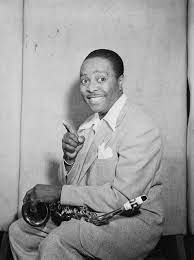Louis Jordan’s birthday anniversary is this month. The saxophonist and clarinet player was born in Brinkley, Arkansas on July 8, 1908 and died in Los Angeles on February 5, 1975. After working with Chick Webb (and Ella Fitzgerald) at the Savoy Ballroom for a few years in the mid-‘30’s, Jordan began leading his own combo at the Elks Rendezvous in Harlem. He made his first recordings in ’38 as the Elks Rendezvous Orchestra, but quickly became Louis Jordan and His Tympany Five, a name inspired by his drummer Walter Martin’s penchant for playing tympani drums in concert. How fortuitous that Martin wasn’t about “more cowbell.”
Jordan enjoyed phenomenal success throughout the ‘40’s, a decade in which he was hailed as “King of the Jukeboxes,” and in which his recordings sold in the millions. He still ranks as the top black recording artist of all time in terms of the total number of weeks he spent at #1, a total of 113 weeks in the top position. From July 1946 through May 1947, Jordan scored five consecutive #1 songs, holding the top slot for 44 consecutive weeks.

One of Jordan’s greatest hits was “Caldonia Boogie,” which he recorded on January 19, 1945. It’s one of several Jordan originals published in the name of his wife, Fleecie Moore. “Let the Good Times Roll” was another. When Fleecie and Louis were divorced (she was wife #2 of 5), she kept the copyright and Jordan lamented, “Ha, she didn’t know anything about music.” But he also admitted that the decision to publish tunes in her name was driven by an attempt to elude previous publishing contracts he’d signed. You might say he was “fleeced” by his own petard.
Here’s a cavalcade of “Caldonia” clips beginning with Jordan, silhouetted and sensational, in a Three Stooges vehicle, “Swing Parade of 1946.” Note how he changes the song’s risqué line, “Mama didn’t know what Caldonia was puttin’ down,” to the more wholesome, “Mama didn’t know I was in love with Caldonia.”
Twenty years later on a Dallas TV show hosted by Hoss Allen, we get to see Jordan in Technicolor with a band that features mainstay drummer Joe Morris (who also went by the names Chris Columbus and Chris Colombo), tenor saxophonist Napolean Fuller, organist Kenny Andrews and guitarist Leo Blevins. This is the only clip I’ve ever seen of Jordan’s organ combo, and while Andrews’ name doesn’t ring a bell with me, two of Jordan’s former sidemen were B3 legends. It was Wild Bill Davis who popularized the Hammond organ in the late ‘40’s when he was with the Tympany Five, and his successor with Jordan, Bill Doggett, later recorded the classic organ shuffle, Honky Tonk.
Another in the profusion of “Caldonia” performances made shortly after the song’s release is seen in this film of the seven-year-old child prodigy Frank “Sugar Chile” Robinson’s appearance in a 1946 Van Johnson movie, “No Leave No Love.”
When Pinetop Perkins succeeded pianist Otis Spann in Muddy Waters’ band in the late ‘60’s, “Caldonia” became one of his features. Here it is in a well-filmed and beautifully played performance from 1978 featuring guitarist Bob Margolin and harmonica player Jerry Portnoy.
And here it is by B.B. King, who’s been playing it for decades and has long credited Jordan’s saxophone playing as a model for his guitar style.
Lastly, take a look at Woody Herman’s Herd in 1964 with a smokin’ version showcasing the tenor players Joe Romano and Sal Nistico, trumpeter Billy Hunt, and trombonists Phil Wilson and Henry Southall. That’s Jake Hanna on drums. Herman was actually the first artist to release “Caldonia.” Decca was a little slow in bringing out the Jordan original, and Herman made it for Columbia on February 26, 1945. He’d got a tip that Jordan had a sensational new tune in his repertoire and beat a quick path to the Paramount to hear it in person. Berle Adams, who managed Jordan between 1942 and ’51, said, Herman “flipped over ‘Caldonia’ so much he went and recorded it as soon as he could, I say within hours, but certainly very quickly.” Jordan noted, “He did it up, real fast; mine was medium tempo.” Indeed, as John Chilton wrote in his biography of Jordan, Let the Good Times Roll, “The trumpet section’s boldly phrased unison figures delighted all those interested in new jazz developments.” On the other hand, Herman’s biographer Gene Lees dismissed Woody’s vocal as “frivolous, with silly screams by the whole band,” but it managed to delight the Leader of the Band’s listeners for decades. Must be something about our “hard heads” that makes it so agreeable.
